Note: Just here for the brevity the examples are simplified, so they do not justify my intentions. If I would be just writing to a memory location exactly like as in the example, then the C would be the best approach. However, I'm doing stuff where I can't use C in this example even when in general it would be best to stay in C.
I'm trying to load registers with values, but I'm stuck to using 8-bit immediates.
My code:
https://godbolt.org/z/8EE45Gerd
#include <cstdint>
void a(uint32_t value) {
*(volatile uint32_t *)(0x21014) = value;
}
void b(uint32_t value) {
asm (
"push ip \n\t"
"mov ip, %[gpio_out_addr_high] \n\t"
"lsl ip, ip, #8 \n\t"
"add ip, %[gpio_out_addr_low] \n\t"
"lsl ip, ip, #2 \n\t"
"str %[value], [ip] \n\t"
"pop ip \n\t"
:
: [gpio_out_addr_low] "I"((0x21014 >> 2) & 0xff),
[gpio_out_addr_high] "I"((0x21014 >> (2+8)) & 0xff),
[value] "r"(value)
);
}
// adding -march=ARMv7E-M will not allow 16-bit immediate
// void c(uint32_t value) {
// asm (
// "mov ip, %[gpio_out_addr] \n\t"
// "str %[value], [ip] \n\t"
// :
// : [gpio_out_addr] "I"(0x1014),
// [value] "r"(value)
// );
// }
int main() {
a(20);
b(20);
return 0;
}
When I write a C code (see a()) then it gets assembled in Godbolt to:
a(unsigned char):
mov r3, #135168
str r0, [r3, #20]
bx lr
I think it uses the MOV as pseudo instruction. When I want to do the same in assembly, I could put the value into some memory location and load it with LDR. I think that's how the C code gets assembled when I use -march=ARMv7E-M (the MOV gets replaced with LDR), however in many cases this will not be practical for me as I will be doing other things with.
In the case of the 0x21014 address, the first 2 bits are zero so I can treat this 18-bit number as 16-bit when I shift it correctly, that's what I'm doing in the b(), but still I have to pass it with 8-bit immediates. However, in the Keil documentation I noticed mention of 16-bit immediates:
https://www.keil.com/support/man/docs/armasm/armasm_dom1359731146992.htm
https://www.keil.com/support/man/docs/armasm/armasm_dom1361289878994.htm
In ARMv6T2 and later, both ARM and Thumb instruction sets include:
A MOV instruction that can load any value in the range 0x00000000 to 0x0000FFFF into a register. A MOVT instruction that can load any value in the range 0x0000 to 0xFFFF into the most significant half of a register, without alteringthe contents of the least significant half.
I think my CortexM4 should be ARMv7E-M and should meet this "ARMv6T2 and later" requirement and should be able to use 16-bit immediates.
However from GCC inline assembly documentation I do not see such mention:
https://gcc.gnu.org/onlinedocs/gcc/Machine-Constraints.html
And when I enable the ARMv7E-M arch and uncomment the c() where I use the regular "I" immediate then I get a compilation error:
<source>: In function 'void c(uint8_t)':
<source>:29:6: warning: asm operand 0 probably doesn't match constraints
29 | );
| ^
<source>:29:6: error: impossible constraint in 'asm'
So I wonder is there a way to use 16-bit immediates with GCC inline assembly, or am I missing something (that would make my question irrelevant)?
Side question, is it possible to disable in the Godbolt these pseudo instructions? I have seen they are used with the RISC-V assembly as well, but I would prefer to see disassembled real bytecode to see what exact instructions these pseudo/macro assembly instructions resulted.
